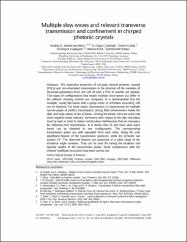| dc.contributor.author | Serebryannikov, Andriy E. | |
| dc.contributor.author | Cakmak, A. Ozgur | |
| dc.contributor.author | Colak, Evrim | |
| dc.contributor.author | Caglayan, Humeyra | |
| dc.contributor.author | Kurt, Hamza | |
| dc.contributor.author | Ozbay, Ekmel | |
| dc.date.accessioned | 2020-02-14T11:42:06Z | |
| dc.date.available | 2020-02-14T11:42:06Z | |
| dc.date.issued | 2014 | en_US |
| dc.identifier.issn | 1094-4087 | |
| dc.identifier.other | DOI: 10.1364/OE.22.021806 | |
| dc.identifier.uri | https://hdl.handle.net/20.500.12573/165 | |
| dc.description | This work is supported by the projects DPT-HAMIT, ESF-EPIGRAT, and NATO-SET-181, and by TUBITAK under Project Nos., 107A004, 109A015, 109E301, and 110T306. A.E.S. thanks TUBITAK for partial support in the framework of the Visiting Researcher Program. H.K. and E.O. acknowledge partial support from the Turkish Academy of Sciences. | en_US |
| dc.description.abstract | The dispersion properties of rod-type chirped photonic crystals (PhCs) and non-channeled transmission in the direction of the variation of structural parameters from one cell of such a PhC to another are studied. Two types of configurations that enable multiple slow waves but differ in the utilized chirping scheme are compared. It is demonstrated that the multiple, nearly flat bands with a group index of refraction exceeding 180 can be obtained. For these bands, transmission is characterized by multiple narrow peaks of perfect transmission, strong field enhancement inside the slab, and large values of the Q-factor. Among the bands, there are some that show negative phase velocity. Symmetry with respect to the slab mid-plane must be kept in order to obtain constructive interferences that are necessary for reflection-free transmission. It is shown that 15 and more slow wave bands can be obtained in one configuration. The corresponding transmission peaks are well separated from each other, being the only significant feature of the transmission spectrum, while the Q-factor can exceed 10(5). The observed features are preserved in a wide range of the incidence angle variation. They can be used for tuning the locations and spectral widths of the transmission peaks. Some comparisons with the chirped multilayer structures have been carried out. (C) 2014 Optical Society of America | en_US |
| dc.description.sponsorship | Turkiye Cumhuriyeti Kalkinma Bakanligi ESF-EPIGRAT Turkiye Bilimsel ve Teknolojik Arastirma Kurumu (TUBITAK) 107A004 109A015 109E301 110T306 Turkish Academy of Sciences NATO-SET-181 | en_US |
| dc.language.iso | eng | en_US |
| dc.publisher | OPTICAL SOC AMER, 2010 MASSACHUSETTS AVE NW, WASHINGTON, DC 20036 USA | en_US |
| dc.relation.ispartofseries | Volume: 22 Issue: 18 Pages: 21806-21819; | |
| dc.rights | info:eu-repo/semantics/openAccess | en_US |
| dc.subject | LIGHT | en_US |
| dc.subject | GUIDES | en_US |
| dc.subject | LOCALIZATION | en_US |
| dc.subject | RESONATOR | en_US |
| dc.title | Multiple slow waves and relevant transverse transmission and confinement in chirped photonic crystals | en_US |
| dc.type | article | en_US |
| dc.contributor.department | AGÜ, Mühendislik Fakültesi, Elektrik & Elektronik Mühendisliği Bölümü | en_US |
| dc.contributor.institutionauthor | | |
| dc.identifier.doi | 10.1364/OE.22.021806 | |
| dc.relation.publicationcategory | Makale - Uluslararası Hakemli Dergi - Kurum Öğretim Elemanı | en_US |


















